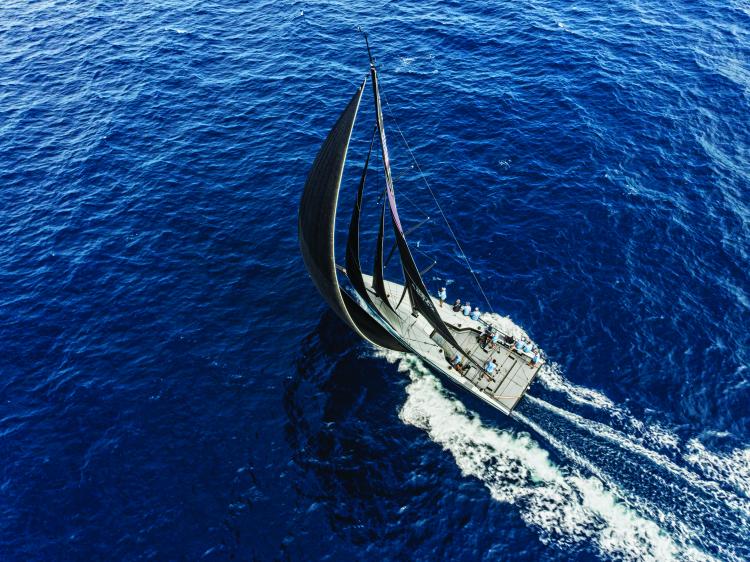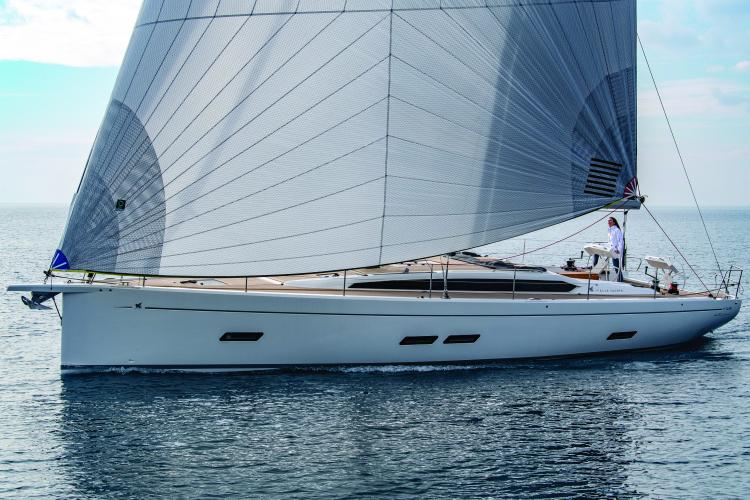Figuring Out Which Reaching Sails Are Best for Your Sailing Style
Welcome to a brave new world of downwind sailing where a range of options are available to help get you from here to there. Call them… oh, call them whatever you want. As always sailmakers’ marketing departments are making this space horribly confusing. There is a long history of needing to put a name on a particular sail type in an attempt to impart a measure of uniqueness and “only available from us” (fill in your favorite brand). There is a storied tradition of forgettable monikers. Who remembers the Flasher, or the Frisbee mainsail? Or one of my favorites, the Shark Skin mainsail (woven materials dyed grey)? Why can’t we just call an asymmetrical spinnaker an asymmetrical spinnaker?

Though the terminology is fluid, they are typically loosely referred to as Code Zeros, or just Code sails. They are specialized sails for reaching angles. It is important to understand that this is actually more than just one sail. That is where the confusion lies. The space between 50 and 130 degrees true wind angle (no man’s land for downwind asymmetricals) is a big design window. A range of sail sizes, shapes, and materials is needed to cover this. The simple way to think of it is in terms of target apparent wind angles. After all, apparent wind angles (AWA) are how we actually sail. Think of a sail as defined by the closest possible apparent wind angle you could expect to sail at, and the overall optimum range.
How size, girth, depth, and balance between luff and leech area affect performance.
Sail size is, of course, a critical design feature. The optimum foot length for any downwind sail is really a function of aspect ratio, or the height (luff) versus width (foot). Too tall and skinny, and the sail will not be stable. Too wide and short, and the sail will not twist properly and take on a good flying shape. No matter what type of downwind sail you are building, you have to start with the correct aspect ratio for the boat’s rig proportions. This is what dictates size.
The next critical dimension is the girth of the sail half way up. The smaller the mid-girth the more genoa-like the sail becomes and the more capable the design is at closer apparent wind angles. Bigger girths mean wider apparent wind angles. A genoa has a mid-girth of 50 percent; a running asymmetrical has a mid-girth of 100 percent plus. You can do everything in between. As a rough guideline the table of target apparent wind angles can be associated with a specific mid-girth.
Reaching
AWA MID-GIRTH
40-100 50-60%
60-120 60-70%
80-130 70-80%
Overall depth is the next variable. Flatter sails mean closer apparent wind angles. Fuller designs mean broader angles. As a sail design gets wider (bigger mid-girth), additional depth is necessary to support the area or the sail will just flap at the edges.
The final variable is how much area is placed outside of the straight line luff and leech. For very close apparent wind angles the luff will be virtually straight, and any additional girth (over 50 percent) will be in the back end. As you design for wider apparent wind angles, this balance gradually shifts, with more of the sail’s width shifted to the front end. For pure running asymmetrical designs, there is a significant amount of area forward of the straight line luff. When the sheet is eased this area can be eased past the centerline and project to windward. This is what helps us sail broad apparent wind angles.

Torsional luff rope or cableless?
More than four years ago racing sailors began experimenting with designs that replaced the traditional torsional luff rope used to allow furling of reaching sails. Instead, additional structure was built directly into the luff of the sail itself. Design teams from the top sailmakers in the class led the way in the development of these “structured luff” or cableless sails in the Maxi 72 class. Now this technology is available to all sailors, racers, and cruisers. While not practical for all downwind sails (bigger asymmetricals with wide girths are difficult to use with furlers, cable or no cable), cableless designs are great for reaching applications.
They offer a number of other advantages, including better flying shapes and lighter weight. Any close-reaching specialty sail can be built with a traditional torsional cable or with a reinforced luff. To be perfectly factual, even cableless designs use a rope to help support the luff. They are not totally cable-free. Flying most of the load is on the additional structure, but to aid in furling more luff tension is required. A rope, though one much smaller than in a traditional setup, helps take the load.
Materials. Nylon versus composites.
For more traditional downwind asymmetrical designs, nylon is still a good choice. However, for the new generation of specialized reaching designs stronger materials are needed to handle the higher loads generated at closer apparent wind angles. Depending on boat size, righting moment, and target apparent wind angle, this could be as simple as a heavier nylon or polyester spinnaker cloth, or it could require composite materials with more strength. There is a whole range of options here, so this is where you need guidance from your sailmaker.
Handling. Furling (top down and bottom up) versus spinnaker socks.
Furling units can be divided into two types: bottom up and top down. Bottom-up systems work the same way conventional headsail roller furling systems do, except that instead of aluminum foils wrapped around a fixed stay, a torsional rope or structured luff is used. The tack is fixed to the drum at the bottom. As the drum is turned, the tack winds around the cable or sail luff, and the sail furls from bottom to top. Bottom-up units work fine as long as the sail is not too wide at the top. Ideally, the sail should be very genoa-like. The mid-girth should not be too much greater than 50 percent. Probably no more than 60-65 percent. AWA 40 and AWA 60 should work fine with this type of system.
As downwind sails get bigger and the mid girth increases, it gets harder and harder to get the top of the sail to furl if you start from the bottom. This is where top-down furling comes into play. The head is attached directly to the swivel at the head. The tack is secured to a free-rotating fitting on the drum. As the furling line is pulled, the tack lags behind, and the head furls first. The sail furls from the top down, capturing the hard-to-furl top sections first.
No matter how well the furling system works, there are still limits. Full size broad reaching and running spinnakers have mid-girths of as much of 100 percent of the foot length and are very deep. These can still be problematic to furl. As a rough guideline, if the mid-girth is much over 88-90 percent of the foot length, all bets are off. It might furl. It might not.
This is when a spinnaker sock still makes the most sense. They are still a good choice for full-size asymmetrical spinnakers designed for broad reaching and running. They are also more cost effective, since a good top-down furling system with a proper torsional rope can easily cost as much as the sail.
The bottom line is that for furling smaller and flatter is better. Full size, think sock.




